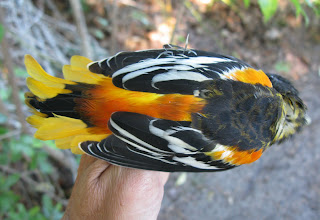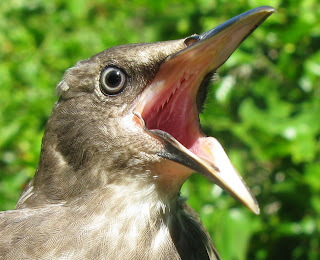Wow, it certainly has been a banner year for numbers of birds and ticks on birds this summer. I've only been able to open a portion of the nets I usually do and have plenty of birds to keep us busy. Ticks removed from birds in the past two weeks numbered close to 300. Although I showed you a tick on a robin in an earlier post, here is a young Carolina Wren with one that is clearly visible below the eye.
On Saturday the 17th, Gretchen, Carolyn, Judy, and I opened 14 nets for 3 hours and captured 54 birds. We had nothing different from the usual suspects, but did capture a first year Brown-headed Cowbird (grrrr....). I wonder what poor warbler species or Song Sparrow ended up raising this bird. As you may know, Brown-headed Cowbirds don't build their own nest but deposit their eggs in the nests of other birds, particularly warblers. The young hatch and are usually much larger, crowding out the smaller nestlings by eating most of the food fed by the parents and may even push out the other birds. They are a native species to this country, originally found for the most part on the Great Plains associating with bison herds. When the European settlers came to this country and proceeded to cut down most of the forests in the east, the cowbird eventually expanded its range wreaking havoc among the birds in our area.
Juvenile Brown-headed Cowbirds look similar to adult females but have buff-edged body and wing covert feathers.
I didn't band at all the following week, instead spent the week with my vacationing husband kayaking, hiking, biking and general fun. The weekend was rainy, so Judith Bruce and Lyndsay Walls assisted me on Monday the 26th. I had another first year male Prairie Warbler molting into his preformative molt. He had fairly large chestnut back feathers but was molting the feathers on his head so the dark facial pattern was not evident.
He also had a good amount of white in his outer tail feathers.
While young Yellow Warblers that lack red streaking on the breast are not necessarily females, this handsome boy was clearly a male showing off his somewhat indistinct red breast streaks.
Wednesday was a good day with our first fall migrants coming through. We banded three Northern Waterthrush, which is actually not a thrush, but a species of warbler.
First year waterthrushes have rusty tipping to their tertial feathers (the three inner secondary feathers next to my lower two fingers) not present in adults, although the rusty coloration is typically worn off by spring.
On Wednesday a beautiful male Baltimore Oriole who was going through his annual molt flew in.

The next day I captured a juvenile male for a good comparison.
He had molted most of his median coverts (larger feathers on the wing with orange and edged in white) and was working on his inner greater coverts (feathers below the med covs). The orange-edged med coverts is a helpful clue that this is a male, females usually have white-edged med coverts shown in the photo below of this young female.
This bird had adventitious molt going on in the right wing, she was replacing her first two primaries, but this was not present in her other wing. It is always important to check both wings in case it might fool you into thinking this was an adult. First year Baltimore Orioles don't have a complete molt their first year. They will retain their primaries, secondaries, primary coverts, and tail feathers replacing them in their second year.
Speaking of adventitious molt, sometimes banders can use this type of molt as a clue to the bird's age seen in this Common Yellowthroat. The pointed tail feathers (rectrices or rects for short) on the right side are juvenile, but has lost some of its left outer rects, replacing them with adult feathers. You can see one of them is clearly more rounded and wider.
Tail feathers come out rather easily. This is probably a survival mechanism so if a predator grabs a bird by the tail they can "drop" them and escape. I had a young catbird going through the same thing with his tail. You can see the replaced fatter, darker adult rects coming in on the right side of the photo.
More Eastern Phoebes arrived, both adults molting and young birds. This second year bird had a brood patch but was no longer incubating eggs.
 |
We captured numerous young phoebes in the same net area, probably her young. See how much fresher they look!
The "whiskers" on this phoebe's face are known as rictal bristles and are actually hairlike feather projections. They are present in flycatchers and insect-eating birds, thought to protect the face from scaly insects, but we don't really know for sure.
A young European Starling let me have it. Warblers are often docile while I'm taking their picture, but no so with starlings- check it out:
A close up shows the ragged roof of its mouth thought to help grind up those juicy hairy caterpillars they like to consume.
On Friday I was so excited, YES! I've finally confirmed a species as a breeder on Wing Island, one I have suspected of breeding there but never had positive proof. A Saltmarsh Sparrow!
Their old name, Saltmarsh Sharp-tailed Sparrow came from their very pointed tails.
She had a full brood patch with fluid visible.
We ended the week on Saturday handling a whopping 91 birds, I was happy I had plenty of help. Carolyn came back with a poor juvenile catbird with the worst case of a deformed upper mandible than I have ever seen.
Surprisingly, this bird was obviously able to eat as its weight, although a bit lighter, was comparable with other catbirds at this time of year. I doubt he will make it to next year though.
On a happier note, our first Red-eyed Vireos showed up today. We've never had one earlier than mid August and we've never had Northern Waterthrushes before the end of August. Guess the birds had such a good breeding year they are heading out early.
As adults the red eye is very prominent but hatching year birds have brown eyes, a quick clue to age.
Thanks very much to the following people for helping out at some point during the last two weeks: Judith Bruce, Judy Keller, Carolyn Kennedy, Gretchen Putonen, Jessica Rempel, and Lyndsay Walls. The following birds were seen, heard, or captured during 17-31 July. Numbers reflect captured birds only.
Total birds: 372 Total species: 52
Total banded species: 23 Birds/100 net-hours: 98
Turkey Vulture
Osprey
Red-tailed Hawk
Northern Bobwhite
Greater Yellowlegs
Willet
Least Sandpiper
Herring Gull
Great Black-backed Gull
Least Tern
Ruby-throated Hummingbird-4
Red-bellied Woodpecker
Downy Woodpecker-7
Hairy Woodpecker
Yellow-shafted Flicker
Eastern Phoebe-8
Great Crested Flycatcher
Eastern Kingbird-4
Tree Swallow
Barn Swallow
Blue Jay
American Crow
Fish Crow
Black-capped Chickadee-37
Tufted Titmouse-11
Red-breasted Nuthatch
White-breasted Nuthatch
Carolina Wren-4
House Wren-1
Eastern Bluebird
American Robin-4
Gray Catbird-153
Northern Mockingbird
Cedar Waxwing
European Starling-1
Red-eyed Vireo-1
Yellow Warbler-17
Prairie Warbler-7
Northern Waterthrush-3
Common Yellowthroat-42
Northern Cardinal-6
Eastern Towhee-2
Saltmarsh Sparrow-1
Song Sparrow-52
Common Grackle
Brown-headed Cowbird-1
Baltimore Oriole-5
House Finch-1
American Goldfinch
House Sparrow

























No comments:
Post a Comment